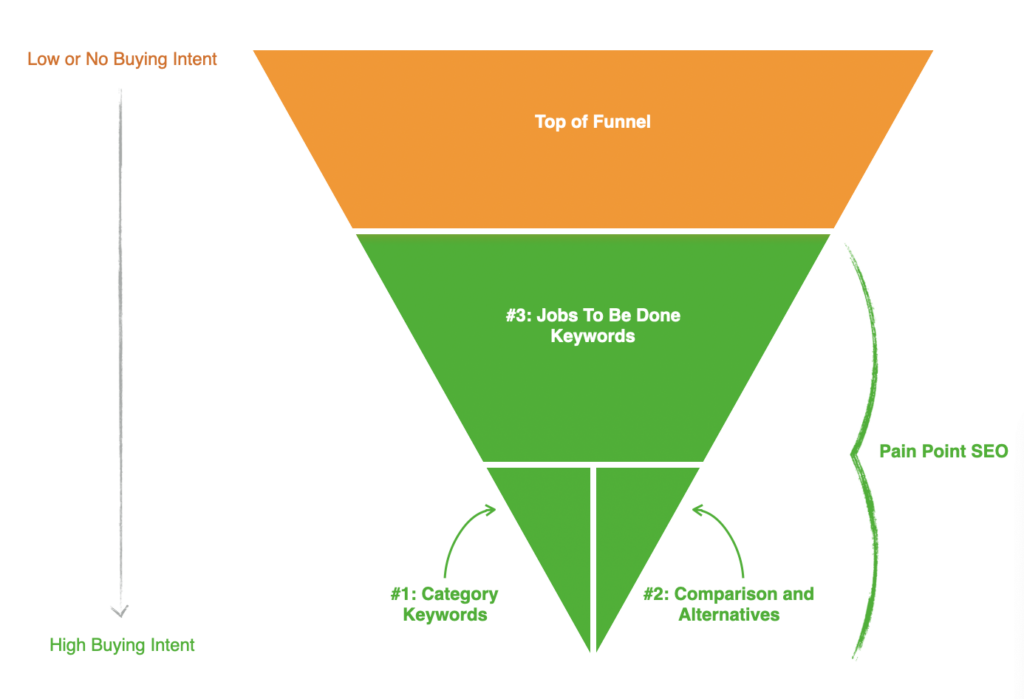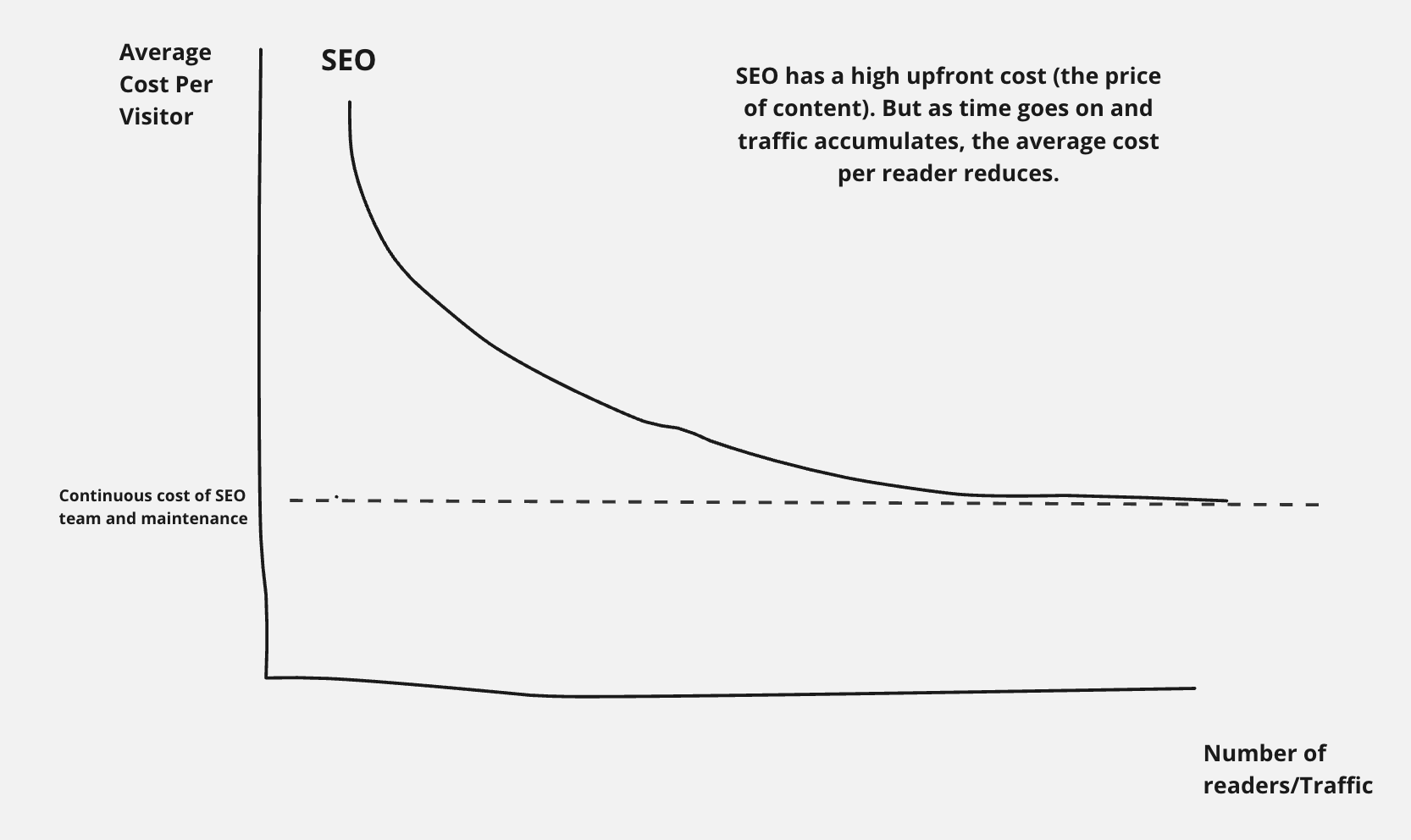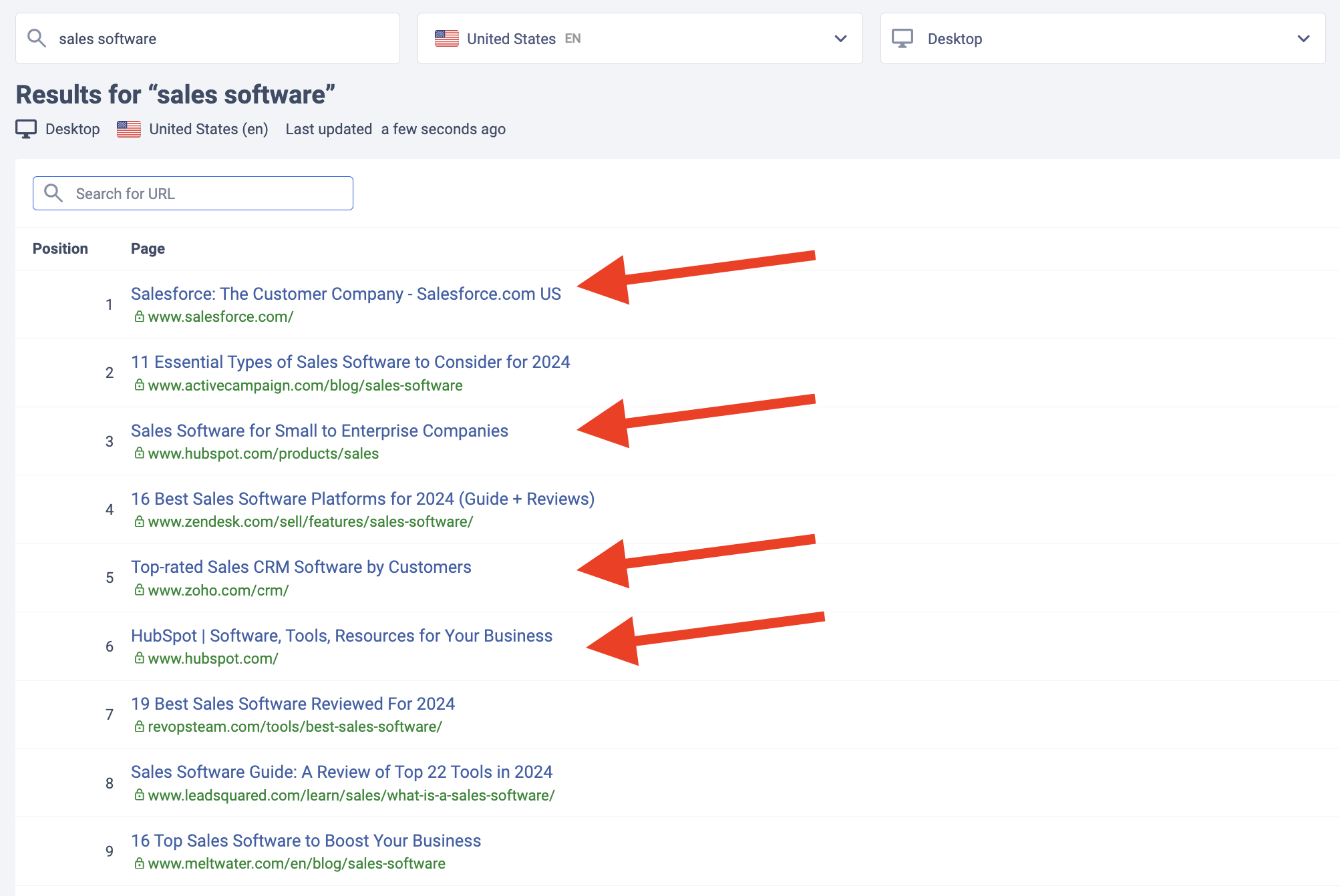In this week's newsletter, I've pulled 7 quotes from seriously successful SEO leaders who appeared on the How the Fxck podcast.
Each one is designed to push forward your knowledge of how to drive actual revenue outcomes via SEO.
Let's dive in.
1. Is SEO Even a Valid Growth Strategy for YOUR Business?
Jake Stainer, Co-Founder at Skale SEO Agency:
“You have to compare it to the lifetime value of your SaaS and work out, is it worth the effort? Because if it's high effort, you need the big lifetime value to recuperate that investment and make the investment worthwhile.”
In both my interviews with Jake, we discussed his “growth modeling” approach to SEO.
He builds mathematical "growth" models to understand how much it will cost to win certain keywords and whether the juice is worth the squeeze (i.e. the revenue results from winning that keyword are worth the price you pay to win).
If you truly boil SEO down to its fundamentals, winning a keyword is a mathematical equation of three key factors: backlinks, quality content, and time.
Some industries are VERY competitive in the SEO channel. They have a lot of high-authority sites with tons of great content.
Beating competing sites in those niches is a “high effort” SEO campaign, which would typically only be worth the investment if there’s lots of bottom-of-funnel search demand and the lifetime value of your product/services is high.
The best way to know if it's worth it?
Model it out.
Ask yourself:
- How many links will we need to match competitor comparables?
- How much will it cost to write a topic cluster and build topical authority?
- What's our expected conversion rate from the content?
- What's the lifetime value of those conversions?
If lifetime value minus costs is positive, invest.
Learn more about this approach in these two interviews:
- How Maze Built an SEO Revenue Engine. And You Can, Too.
- How Typeform Built SEO into a $3M Annual Lifetime Revenue Channel
2. Are You Addressing Pain Points with Your SEO Strategy?
Benji Hyam, Co-Founder of Grow and Convert
“We target keywords that indicate people have high buying intent first, before moving “up the funnel”.
In this interview with Benji we discussed the concept of “Pain Point SEO.”
This approach is how most smart SEOs now build SEO strategies.
It focuses on identifying and targeting high-intent keywords that are likely to drive direct conversions.
"Pain Point SEO is a strategy that we coined describing how to prioritize content ideas around high-intent keywords over high-volume keywords with the goal of driving conversions."

Benji's approach leans on the idea that certain keywords show more "buying intent" than others, and if you can target and prioritize the keywords with the highest buying intent you're more likely to drive revenue outcomes.

Listen to the full interview and case study here.
3. Is Your Content Valuable Enough to Advertise?
Tim Soulo, CMO at Ahrefs:
“Your content has cost to create and so it should be valuable enough that you should want to advertise it."
Tim's philosophy is that content should be seen as an investment that drives substantial returns.
Which means you should know why you're creating content and know it will have a positive business result.
At Ahrefs, the content strategy focuses on creating highly valuable, product-focused content that educates users and showcases the product's capabilities.
Any reader of the Ahrefs blog will know they do a really amazing job at weaving the product into their guides, showing off its value and making you want to use the product.
That's by design.
Each article is almost a sales page for the features and use cases of the product. That makes it so valuable it's worth promoting, and if you wouldn't advertise it, why create it?
Content can contribute to revenue in a variety of ways, however.
Through:
- Direct leads
- Retention
- Account expansions
- Word of mouth
- Brand exposure
- Brand affinity/thought leadership
The Ahrefs team creates detailed guides and tutorials that are both useful to existing customers and compel future customers to try the product.
They’ve even developed their own way of determining the business value of a keyword.
They call it the “business potential,” and it’s a simple score from 0 to 3, which indicates how easy it will be to pitch their product while covering a given keyword.
Listen to the full episode with Tim Soulo here.
4. How Does UX & Blog Design Pull Users Down the Funnel Effectively?
Sean Potter, Senior Content Strategist at Hotjar:
“We don't want someone to learn about website tracking and then disappear. We want them to want to learn more. The navigation [of our blog page] funnels [readers] towards the next step of their journey and level of knowledge”
In my conversation with Sean, he emphasized the critical role of user experience (UX) and blog design in Hotjar's SEO strategy.
Hotjar's navigation on their "guides" is consciously designed to pull you to the "next step" once you've learned something.
Sean tells us how Hotjar tests and optimizes their blog design to capture traffic at the top of the funnel and then retain it, driving the reader further along the buying journey.
The content is created in topic clusters that cover the full buying funnel (From "what is X?" to "Best X Tools").
By organizing content around specific themes and ensuring each piece links to others in the cluster, they effectively guide users through their buying journey.
Hotjar's strategy led to a 47% increase in organic search traffic over 2 years and significant revenue growth, demonstrating the power of well-designed content structures in driving SEO success.
Listen to the full episode with Sean here.
5. Are You Collaborating with Paid Acquisition Teams for SEO?
Zoe Averbuch, Senior SEO Manager at monday.com:
"I know content is expensive but when you compare content to bidding and running ads it pales in comparison. So, when you compare it to the budget for acquisition it was an easy win in that sense."
In my interview with Zoe & Eliana from monday, they shared how Monday.com’s SEO strategy benefits from collaboration with their paid acquisition team.
By leveraging data and insights from years of ad campaigns, they can easily identify high-converting keywords and topics that are worth investing in for SEO.
This allows them to prioritize SEO efforts on content that has proven potential to drive conversions, making the investment in content creation more efficient and impactful.
When discussing SEO vs Paid channels, they sang SEO's praises for a few reasons.
For example, cost per conversion reduces over time (after the upfront investment, it gets better as it takes less work and investment is spread over time, yet conversions still keep coming).

There are lots of ways paid and SEO teams can work together to drive growth. Cross-analyzing conversion data is just one of them (I will cover this topic in a future newsletter!).
Recommend reads:
- Winning Budget: How monday.com Talk About the Value of SEO
- Case Study #1: Producing 1,000 articles per year
- Case Study #2: Monday's SEO strategy from the inside
6. Are You Targeting High-Value Keywords With the Highest-Conversion Content Type?
This is from one of my client case studies:
It’s best practice to target a term like “sales software” with a listicle like “Top 10 Sales Software in 2024”. However, if the term “sales software” wasn’t very competitive, it’s possible to win it with a Service Page that focuses 100% on…you…and still rank #1. With this client, I’m following a variation of this approach and a few other techniques to rank them #1 for key bottom-of-funnel terms.—Ben Goodey, How I Got My Client +50% Revenue in 6 Months
In an ideal world, you would rank #1 for your bottom-of-funnel search terms with a product-focused landing page.
But, anyone who has ever tried to target a term like "sales software" will know it's incredible hard to do so.
For example, let's look at the SERP:

Companies like Salesforce and Hubspot have done it. Salesforce is #1 for "sales software" with their homepage—which must be incredible for driving high-intent traffic and conversions. Ideal situation to be in.
But, for you to do the same would be nearly impossible for this query. Salesforce and Hubspot are both in the top 500 most authoritative websites worldwide.
To win this keyword, you'd have a much easier time ranking in the top 10 with a product listicle.
How do I know?
The evidence is in the current SERPs. The current #7 ranked article, Rev Ops Steam, has only a DR 47 and barely makes it into the top 100,000 websites yet is performing well.
Hoewver, this situation is NOT always the case.
On lower competition keywords, usually in niches that have underinvested in SEO or where a new topic has emerged, you can still rank #1 with a service page.
For example, in my case study with a financial services client, we are ranking services pages across a ton of terms.
You have to be a pro at keyword research to find the opportunities, but when you do conversions are off the charts:
My full secret sauce for ranking a service page #1 is currently reserved for clients.
7. Why is Middle-of-Funnel Content Crucial for Driving Revenue?
Josh Spilker, Head of Content at ClickUp
"Middle-of-funnel content works incredibly well for capturing demand, especially for freemium products."
By targeting list posts such as "best project management tools" or "top productivity software," ClickUp was able to rank high for competitive keywords and drive significant traffic and conversions.
Josh's strategy involved creating comprehensive clusters of content around key topics, ensuring internal linking to boost SEO, and incorporating external backlinks to enhance visibility.
They created a cluster around keywords like 'free project management software' and supported it with external links and comprehensive internal linking,
One of the standout points from the episode was Josh's focus on publishing velocity.
"The secret sauce is the velocity—publishing as much as you can, as fast as you can," he said. This approach helped ClickUp achieve rapid growth and establish authority in the project management space.
Josh also highlighted the importance of detailed briefs for freelance writers (something I also harp on about continuously), ensuring they had all the necessary information to produce high-quality content.
"I spend about 45 minutes to an hour on each brief, providing stats, internal links, and external research."
Learn more about how to optimize middle-of-funnel content here:
- The #1 choice that drives $$ from SEO: https://seo.thefxck.com/articles/the-1-thing/
- How to find hidden high-converting keywords: https://seo.thefxck.com/articles/find-high-converting-keywords-in-search-console/
Listen to the full interview with Josh here.
Thanks for reading!
As always, I appreciate you being a part of the How the F*ck community. 🫶🏼
—Benny
How I Can Help You Accelerate Your Organic Growth
One:
The Scalable SEO Operation Package: Join 100s of SEOs & Content Leaders inside the Scale Package. This is a comprehensive guide, dashboard and templates for building a scalable content operation that drives real revenue results. I've personally used this system to scale my latest client to 100,000 clicks/month in 7 months—in as little as 2 hours per week of management.
Use code: FRIENDS10 to get a 10% discount.
Two:
Become a How the F*ck Premium member: Join 247 monthly members who enjoy access to 30+ of the most incredible SEO case studies. You'll unlock all of the case studies mentioned in this newsletter.
Three:
Work with me! I'm currently taking on new clients, I literally have space for one more. We help you scale your organic traffic and build revenue-generating websites. Book an intro call here. You can also book a consulting hourrevenue-generating with me here to clarify your strategy.


